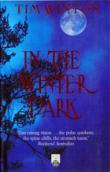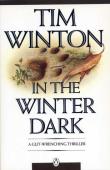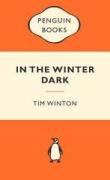AustLit
Latest Issues
AbstractHistoryArchive Description
'Night falls. In a lonely valley called the Sink, four people prepare for a quiet evening. Then in his orchard, Murray Jaccob sees a moving shadow. Across the swamp, his neighbour Ronnie watches her lover leave and feels her baby roll inside her. And on the verandah of the Stubbses’ house, a small dog is torn screaming from its leash by something unseen. Nothing will ever be the same again. ' (Publication summary)
Adaptations
-
form
y
 In the Winter Dark
( dir. James Bogle
)
Australia
:
Goalpost Pictures
,
1998
Z1866949
1998
single work
film/TV
horror
In the Winter Dark
( dir. James Bogle
)
Australia
:
Goalpost Pictures
,
1998
Z1866949
1998
single work
film/TV
horror
In an isolated valley, four unrelated people, each with their own loneliness and uncertainties, are brought together when a mysterious creature begins killing local livestock.
Based on Tim Winton's novel, this film was low budget but highly regarded by critics.
Publication Details of Only Known VersionEarliest 2 Known Versions of
Other Formats
- Sound recording.
- Large print.
Works about this Work
-
The Haunting Power of Dreamscapes within Tim Winton’s Gothic Novella In the Winter Dark
2022
single work
essay
— Appears in: TEXT Special Issue , no. 68 2022; 'Nightmares and their aesthetics of terror have been linked to Gothic literature since the birth of the genre during the pre-Romantic era. Indeed, many early authors of the form, including Horace Walpole, Ann Radcliffe and Mary Shelley, were driven to articulate the content of disturbing dreams via their literary work. Significantly, dark literary dream sequences continue to be a cornerstone feature of many contemporary Gothic texts. In this paper, I reflect upon some of the uniquely Australian Gothic tropes on display within Tim Winton’s 1988 novella, In the Winter Dark, while also discussing the various functions performed by dreamscapes within this work. In addition, and with occasional reference to Freudian concepts, I explore the use of Winton’s nightmare sequences to re-present, in recurring fashion, the fragmented sense of self to which his protagonists are subject as they struggle to recover from traumatic events (or not recover, as the case may be). Finally, I discuss the capacity of dreamscapes within this novella to contribute to narrational and structural strategies in ways that are aesthetically powerful and innovative.' (Publication abstract) -
Tim Winton's In the Winter Dark and the Settler Condition
2018
single work
criticism
— Appears in: Antipodes , vol. 32 no. 1/2 2018; (p. 58-72) 'In discussing the creative processes that underpin his novels, Tim Winton himself identifies the importance of place: "The place comes first' If the place isn't interesting to me then I can't feel it. I can't feel any people in it. I can't feel what the people are on about or likely to get up to" (Steger). For this reason, Winton has often been perceived as a writer who champions belonging. Some critics even argue that his narratives reinforce conservative, settler-colonial attitudes to place. Jennifer Rutherford, for instance, analyzes The Riders as a narrative of belonging that seeks "to reaffirm the legitimacy of white Australian narratives of nation and to reinforce nationalist narcissism" (153). If isolated elements of a particular novel may lead to this conclusion, an analysis of Winton's oeuvre shows that, as he revisits the bush, the ocean, the littoral, the outback, the city, and the suburb, the author does not validate traditional or conservative conceptions of place. Winton may be a popular writer, but he does not allow his readers to be complacent and accept the legacy of the colonial past. For the past three decades, Winton's fiction has kept probing the contested issue of settler legitimacy. The Rider (1994), Dirt Music (2001), Breath (2008), and Eyrie (2013) explore how non-Indigenous Australians attempt to renegotiate spatial relationships in this context of social, cultural, political, and spatial instability. In a recent analysis of Winton's oeuvre, The Fiction of Tim Winton: Earth and Sacred (2016), Lyn McCredden argues that his recent novels question the "supposed stabilities of place" (11) and that "Tim Winton is the poet of non-belonging" (109). ' (Introduction)
-
The Tasmanian Tiger From Extinction to Identity : Myth in White Australian Society and Fiction
2017
single work
criticism
— Appears in: Literary Location and Dislocation of Myth in the Post/Colonial Anglophone World 2017; (p. 67-83)The Thylacine or 'Tasmanian Tiger' today is a well-known and well-loved icon of the Australian world. Although it is probable that the species had already disappeared from mainland Australia by 1788, it was still present in Tasmania when settlement of the island began in 1803. As the colony expanded, this largest surviving carnivorous marsupial came to be seen as such a formidable threat to the pastoral economy that bounty schemes were introduced to eradicate it. Since the last captive thylacine died in 1936, however, it has become a symbol of Australian and more specifically Tasmanian identity. The heraldic crests of several towns in Tasmania feature at least one thylacine as supporter and the State Tasmania has two. It also appears on licence plates and until quite recently graced the labels of the state's best-selling beer.' Nor are all Australians reconciled with the official view that the 'Tassie tiger' should now be considered irreversibly lost. Every year, there are several claimed sightings throughout Australia and thousands of dollars have been put towards the quest for the thylacine, either to try to catch it alive or to clone it back to life using DNA material extracted from museum specimens. Tourist shops cater to thylacine nostalgia by selling T-shirts, magnets, and key-rings adorned with tigers and the caption 'I want to believe' as well as mugs and caps that simply read: 'I'm alive'. Such a reversal in the perceptions of the thylacine, from colonist's bane to national icon and naturalist's grail constitutes a striking example of the complex and contradictory uses mythical constructions of otherness have been put to in settler communities.' (Introduction)
-
Who is My Neighbour? : Tim Winton’s ‘Aquifer’ and the Ghosts of Cloudstreet
2017
single work
criticism
— Appears in: Australian Literary Studies , February vol. 32 no. 1 2017;'The psychology of guilt as debt is a recurrent theme in Tim Winton’s fiction. A number of scholars have recently examined the theme of haunting in Winton’s Cloudstreet (1991), arguing that the ghosts which appear in the story represent an engagement with Australia’s colonial past, in particular the mistreatment of its Indigenous peoples. The latest of these, Michael R. Griffiths, highlights the shortcomings of Winton’s treatment of this theme, contending that Winton’s text might be read as a kind of excuse, in the name of naïveté, for colonial abuses. Given that Nicholas Birns (among others) has noted a new maturity in Winton’s work from The Turning (2004) onward, a fresh examination of such themes in Winton’s work is warranted. This essay does so through a reading of the short story ‘Aquifer’. Examining the story’s treatment of the psychology of guilt and debt, the essay explores how Winton tries to resolve the moral and historical problems he raises in regard to Australian culture through the ethical figure of the neighbour, drawn in particular from the biblical parable of the Good Samaritan. By showing the centrality of the neighbour to Winton’s work through references to In the Winter Dark (1988), Cloudstreet, Breath (2009), ‘Aquifer,’ and a newspaper editorial by Winton on the humanitarian treatment of refugees, this paper seeks to provide a new critical window through which to understand his evolving ethical ideas about Australia’s past and future.'
Source: Abstract.
-
‘Over the Cliff and into the Water’ : Love, Death and Confession in Tim Winton’s Fiction
2014
single work
criticism
— Appears in: Tim Winton : Critical Essays 2014; (p. 96-121)'Tim Winton's female characters show a strong tendency towards self-threatening behaviors, transience and ferocity. This is evident in the violent deaths of Jewel in An Open Swimmer, Maureen in Shallows, Ida's murder in In the Winter Dark [...], Tegwyn's self-harm in That Eye, the Sky, Dolly's alcoholism in Cloudstreet, Eva Sanderson's Hutchence-lookalike death in Breath and, obviously, the ephemerality of mothers in Dirt Music...' (96)
-
Plumbing the Depths of Darkness
1987
single work
review
— Appears in: The CRNLE Reviews Journal , no. 2 1987-1988; (p. 68-71)
— Review of In the Winter Dark 1988 single work novel ; The Well 1986 single work novel -
Diverse Voices
1990
single work
review
— Appears in: Social Alternatives , April vol. 9 no. 1 1990; (p. 58-60)
— Review of My Father's Moon 1989 single work novel ; The Fortunes of Mary Fortune 1989 selected work autobiography prose ; The New Diversity : Australian Fiction : 1970-88 1989 selected work criticism ; In the Winter Dark 1988 single work novel ; City to City 1989 selected work short story ; Flawless Jade 1989 single work novel ; Eight Voices of the Eighties : Stories, Journalism and Criticism by Australian Women Writers 1989 anthology criticism extract short story autobiography correspondence prose review interview -
[Review] The Life and Crimes of Harry Lavender [et al]
1988
single work
review
— Appears in: The Sydney Morning Herald , 17 December 1988; (p. 42)
— Review of The Life and Crimes of Harry Lavender 1988 single work novel ; A Chelsea Girl 1988 single work novel ; In the Winter Dark 1988 single work novel -
Dark Interludes
1989
single work
review
— Appears in: The Phoenix Review , Spring no. 4 1989; (p. 111-115)
— Review of Blue Angels 1987 single work novel ; Stopping Over 1988 single work novel ; In the Winter Dark 1988 single work novel -
Going Down the Sink
1989
single work
review
— Appears in: The Times Literary Supplement , 9-15 June no. 4497 1989; (p. 634)
— Review of Inland 1988 single work novel ; In the Winter Dark 1988 single work novel -
y
 Tim Winton : The Writer and His Work
South Yarra
:
Macmillan Education Australia
,
1999
Z1022919
1999
single work
criticism
Aimed principally at younger readers and students, this work contains biographical information about Winton which situates him in a Western Australian context and has chapters dealing with each of Winton's novels to date. Each chapter concludes with a section 'Questions and Activities'.
Tim Winton : The Writer and His Work
South Yarra
:
Macmillan Education Australia
,
1999
Z1022919
1999
single work
criticism
Aimed principally at younger readers and students, this work contains biographical information about Winton which situates him in a Western Australian context and has chapters dealing with each of Winton's novels to date. Each chapter concludes with a section 'Questions and Activities'.
-
Tim Winton's Take on the Weird : In the Winter Dark as Cross-Genre Fiction
2008
single work
criticism
— Appears in: Studies in Australian Weird Fiction , no. 1 2008; (p. 105-112) Ellis argues that Winton's novel is a mixture of weird and literary fiction. -
Shadow of the Dead : Stories of Transience in Tim Winton's Fiction
2012
single work
criticism
— Appears in: Westerly , July vol. 57 no. 1 2012; (p. 164-181)Explores Tim Winton's treatment of female characters in his fiction and their linkage with images of transience and death.
-
The Haunting of History and the Feral Self in Tim Winton's In the Winter Dark
2011
single work
criticism
— Appears in: Hungarian Journal of English and American Studies , Spring vol. 17 no. 1 2011; (p. 71-84) -
Aboriginal Gothic
2010
single work
criticism
— Appears in: Darkness Subverted : Aboriginal Gothic in Black Australian Literature and Film 2010; (p. 11-29) In this essay, Althans ‘treats the Gothic as being a mode which continues to endow genres with a certain set of menacing stock elements and unstable characteristics of which the interrogation of boundaries, binaries, and identity are particularly useful in an Aboriginal Australian context’. (p.11-12)
- Bush,
- Western Australia,
- 1980s









